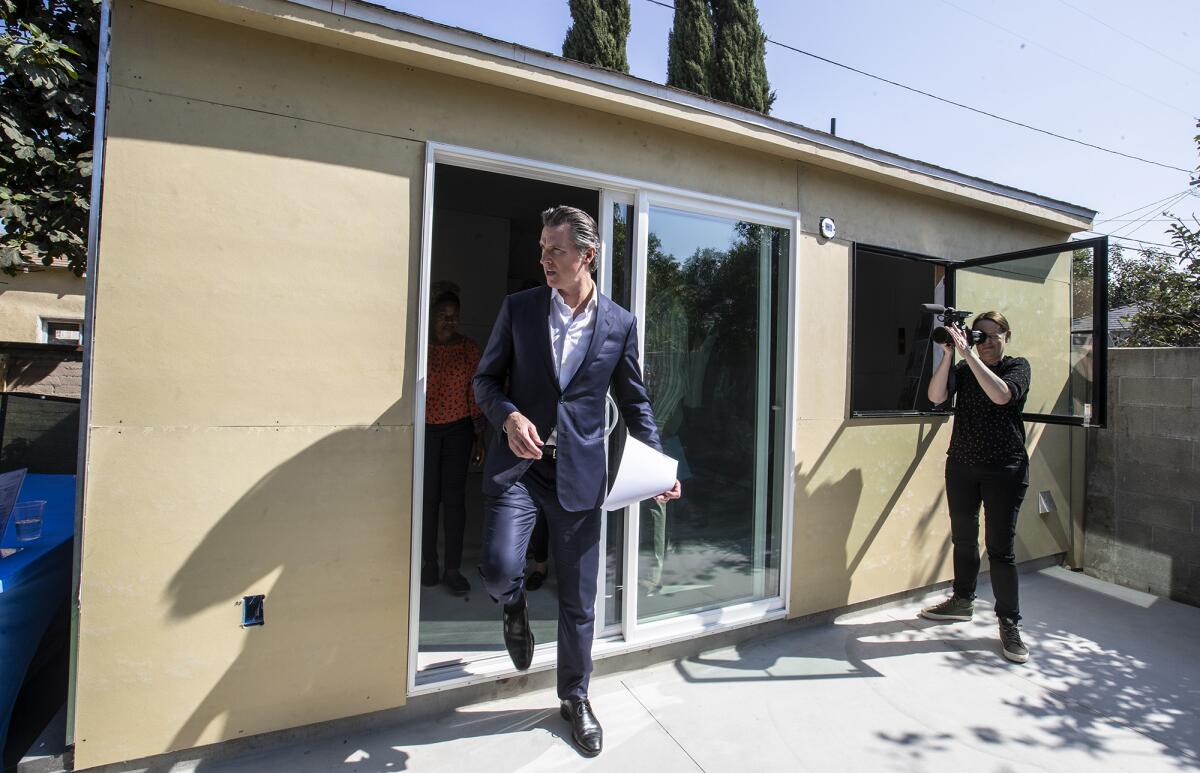Newsom says he’s done a good job fixing California’s housing crisis. Facts say otherwise

- Share via
On the campaign trail and during his first months in office, Gov. Gavin Newsom called for an unprecedented response to California’s housing crisis.
He pledged that his administration would help spur the biggest wave of homebuilding in modern history. And he promised to launch a statewide affordable housing program on par with the nation’s effort to rebuild Europe after World War II.
“Our solutions must be as bold as the problem is big,” Newsom wrote two years ago in a Medium post unveiling his housing plan.
But now at the end of the first legislative year of his term, many of Newsom’s highest-profile initiatives to speed housing production, boost the state’s authority over development decisions and increase private funding for affordable housing have stalled or failed.
While Newsom can point to some successes — notably a new statewide cap preventing large rent increases — there are few signs the state is making the kind of progress Newsom had hoped for in addressing its housing issues, and homelessness is now an even more pressing problem than when he took office.
“It seems like a pretty meaningful failure,” said Michael Lens, an associate professor of urban planning and public policy at UCLA. “Either a failure of commitment or a failure of effort.”
Newsom, however, contends that this year’s work will not only put a dent in the state’s housing problems, but also set up more consequential action going forward. For example, he said new laws that permit more affordable housing to be developed near transit, and prevent cities and counties from passing growth moratoriums lay the groundwork for further state legislation.
The budget also adds nearly $3 billion for housing and homelessness initiatives, and his administration has begun trying to turn underused state properties into low-income housing developments.
Still, the governor’s accomplishments this year don’t match his original agenda. On the campaign trail, Newsom called for the construction of 3.5 million new homes by 2025 — or 500,000 a year — a rate that requires building at a level unseen since the construction industry began keeping statistics in the 1950s.
“It’s a stubborn issue,” Newsom said in an interview with The Times. “You can’t snap your fingers and build hundreds of thousands, millions of housing units overnight.”
The state faces a shortage of 1.7 million affordable rental homes, which in turn has spawned a rapidly worsening homelessness crisis. Funding to build them still lags far behind what’s needed, according to the nonprofit California Housing Partnership.
The governor hasn’t gotten buy-in on his plans to boost housing production from local governments, which may end up signing off on as few as 109,000 new home permits statewide in 2019 — a 6% decrease from last year.
In his inauguration speech in January, Newsom said he would implement “a Marshall Plan for affordable housing,” evoking the billions of dollars in economic assistance after World War II. But while the state significantly increased spending on financing new low- and middle-income housing, much of the money is guaranteed for only one year.
Citing its cost and the impact to the state budget, Newsom vetoed a bill that would have added over time another $2 billion annually for subsidized housing construction.
Newsom never introduced his own plan to substantially boost overall housing production and didn’t throw his political weight behind Senate Bill 50, a measure vehemently opposed by Los Angeles officials that would have allowed the construction of fourplexes in neighborhoods of single-family homes and mid-rise apartments near transit stops and job centers. A legislative committee tabled the bill in the spring.
Other big ideas have also fallen far short of what the governor wanted. When he unveiled his budget proposal in January, Newsom threatened to withhold state transportation dollars from cities that didn’t approve enough housing. That plan failed when fellow Democrats in the Legislature believed the punishment was too strong. Instead, lawmakers added fines for local governments that defy state mandates to plan for, rather than approve, sufficient housing — and even then, that penalty wouldn’t kick in for years.
Newsom also called on tech companies, one of the state’s biggest economic engines, to contribute $500 million to the state treasury to help build new housing for their employees, who frequently have been blamed for displacing residents at the lower end of the wage scale. The money he asked for has not materialized, though in The Times interview Newsom hinted that something could be coming.
“We hope to be making — and I don’t want to get ahead of myself — in the very near term some not so insignificant announcements,” he said.
Newsom also initially threw his support behind negotiations between the state construction worker unions and developers with the goal of adding wage guarantees for workers in exchange for labor’s support to reduce regulations on homebuilding. But the two sides didn’t reach a deal.
Even arguably the governor’s biggest success, the statewide cap on annual rent increases of 5% plus inflation, didn’t go far enough to convince some tenant advocates to withdraw a potential 2020 ballot initiative that would create even stricter rent control regulations.
“The governor has made a lot of promises and has set very high expectations for action in the area of housing,” said Mark Baldassare, president and CEO of the Public Policy Institute of California, which conducted a recent poll showing Californians believe homelessness and housing affordability are the state’s biggest problems. “He hasn’t really given people a sense of how long this is going to take.”
Throughout the spring, major housing bills struggled to gain traction in the Legislature and Newsom was largely absent from the debate. But once his administration became more engaged later in the year, the governor was able to bend policies in his direction. Most significantly, the governor brokered the deal to cap rents even though lawmakers had already rejected a similar version of the same proposal.
Ben Metcalf, who served as director of the state Department of Housing and Community Development under Newsom and former Gov. Jerry Brown until he resigned last month to start a consulting business, said that Newsom’s soaring ambitions on housing were, in part, hemmed in by his equally soaring ambitions to address healthcare, criminal justice reform and other big systemic issues.
“The challenge there — and what he has admitted to — is just when he campaigned on as many things as he did, and he wanted to make progress on all of them in his first year, it’s hard to go deeply on any one of them,” Metcalf said. “That was always one of Brown’s strengths. I think Newsom will probably get there.”
Told of Metcalf’s comments, Newsom strongly rejected the suggestion that his housing agenda lacked focus, saying he achieved largely what he set out to do.
“To set the tone and tenor in the inaugural. To transition to the pragmatic in the budget and in the legislative session. I’m very pleased,” the governor said. “We went deep.”
Still, Newsom conceded that some of his lofty early rhetoric — the 3.5-million home-building number and the reference to the Marshall Plan — requires more specifics. The governor considers the number “a stretch goal.”
In the coming months, he expects the state housing department to release what he calls a more “pragmatic” estimate of the housing needs by region. The process has already involved telling local governments across Southern California that they’ll need to plan for 1.3 million new homes in the next decade.
And the governor said he won’t have followed through on his pledge for a “Marshall Plan” until the state substantively takes on opposition to growth from local governments and neighborhood groups, especially when it comes to building near transit stops.
“You’re going to see a lot more pressure put on cities next year,” Newsom said. “I can assure you, you haven’t seen anything yet. There’s going to be a hell of a lot more pressure coming in the new year.”
That focus on local governments is likely to face strong opposition. Cities and counties, for example, were at the forefront of the pushback to SB 50 as an incursion on their power over housing decisions. Newsom’s more direct efforts to target specific communities are taking a long time to resolve.
At the governor’s urging in January, the state sued the Orange County city of Huntington Beach alleging that it was failing to comply with laws to plan for sufficient housing. A trial date in the case still hasn’t been set. And Huntington Beach has filed its own separate legal action against the state, contending that certain housing laws impinge on the city’s authority to control development decisions. A trial in that case is scheduled for February, but is likely to be delayed so the city can challenge more state housing laws, said Huntington Beach City Attorney Michael Gates.
Gates said his city will continue to fight back and expects whatever side loses in the cases will file appeals. If Newsom wanted to solve the state’s housing problems, Gates said, the governor should push for low-income housing in undeveloped areas instead of already built communities.
“The governor is trying to target these already developed cities, these nice beach cities like Huntington Beach, and say we’re going to force their wholesale redevelopment to create just another welfare program,” Gates said.
Newsom pledged that he remains just as committed to fixing California’s housing problems as he was before taking office.
“This is not an issue that we’re going to get distracted on,” he said. “I am all in on the issue of affordability. We have many, many next acts.”
More to Read
Sign up for Essential California
The most important California stories and recommendations in your inbox every morning.
You may occasionally receive promotional content from the Los Angeles Times.












